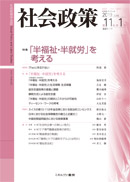Volume 11, Issue 1
Displaying 1-19 of 19 articles from this issue
- |<
- <
- 1
- >
- >|
Foreword
-
2019 Volume 11 Issue 1 Pages 1-3
Published: June 30, 2019
Released on J-STAGE: July 01, 2021
Download PDF (1197K)
Special Issue : Consider"Half Welfare, Half Employment"
-
2019 Volume 11 Issue 1 Pages 5-10
Published: June 30, 2019
Released on J-STAGE: July 01, 2021
Download PDF (1298K) -
2019 Volume 11 Issue 1 Pages 11-25
Published: June 30, 2019
Released on J-STAGE: July 01, 2021
Download PDF (1457K) -
2019 Volume 11 Issue 1 Pages 26-39
Published: June 30, 2019
Released on J-STAGE: July 01, 2021
Download PDF (1415K) -
2019 Volume 11 Issue 1 Pages 40-54
Published: June 30, 2019
Released on J-STAGE: July 01, 2021
Download PDF (1960K) -
2019 Volume 11 Issue 1 Pages 55-67
Published: June 30, 2019
Released on J-STAGE: July 01, 2021
Download PDF (1358K) -
2019 Volume 11 Issue 1 Pages 68-73
Published: June 30, 2019
Released on J-STAGE: July 01, 2021
Download PDF (1299K)
Article
-
2019 Volume 11 Issue 1 Pages 74-84
Published: June 30, 2019
Released on J-STAGE: July 01, 2021
Download PDF (1328K) -
2019 Volume 11 Issue 1 Pages 85-97
Published: June 30, 2019
Released on J-STAGE: July 01, 2021
Download PDF (1492K) -
2019 Volume 11 Issue 1 Pages 98-108
Published: June 30, 2019
Released on J-STAGE: July 01, 2021
Download PDF (1339K)
Book Reviews
-
Article type: book-review
2019 Volume 11 Issue 1 Pages 109-112
Published: June 30, 2019
Released on J-STAGE: July 01, 2021
Download PDF (1295K) -
Article type: book-review
2019 Volume 11 Issue 1 Pages 112-115
Published: June 30, 2019
Released on J-STAGE: July 01, 2021
Download PDF (1291K) -
2019 Volume 11 Issue 1 Pages 116-119
Published: June 30, 2019
Released on J-STAGE: July 01, 2021
Download PDF (1293K) -
Article type: book-review
2019 Volume 11 Issue 1 Pages 119-123
Published: June 30, 2019
Released on J-STAGE: July 01, 2021
Download PDF (1299K) -
Article type: book-review
2019 Volume 11 Issue 1 Pages 123-127
Published: June 30, 2019
Released on J-STAGE: July 01, 2021
Download PDF (1293K)
SUMMARY
-
2019 Volume 11 Issue 1 Pages 128-131
Published: June 30, 2019
Released on J-STAGE: July 01, 2021
Download PDF (1296K)
-
2019 Volume 11 Issue 1 Pages 132-135
Published: June 30, 2019
Released on J-STAGE: July 01, 2021
Download PDF (1295K) -
2019 Volume 11 Issue 1 Pages 135-137
Published: June 30, 2019
Released on J-STAGE: July 01, 2021
Download PDF (1343K) -
2019 Volume 11 Issue 1 Pages Cover2-
Published: June 30, 2019
Released on J-STAGE: July 01, 2021
Download PDF (1885K)
- |<
- <
- 1
- >
- >|
